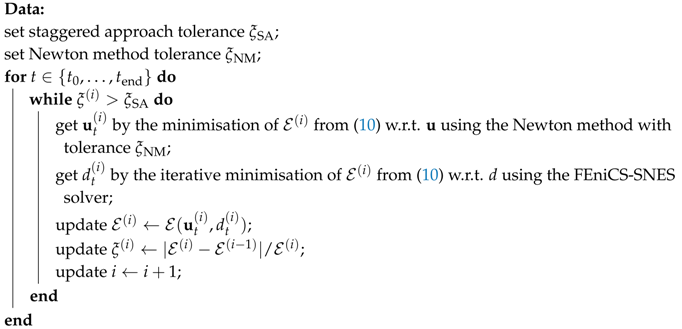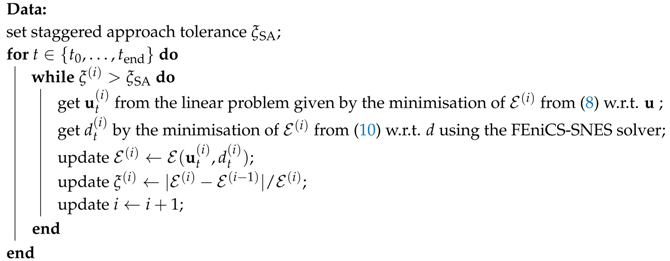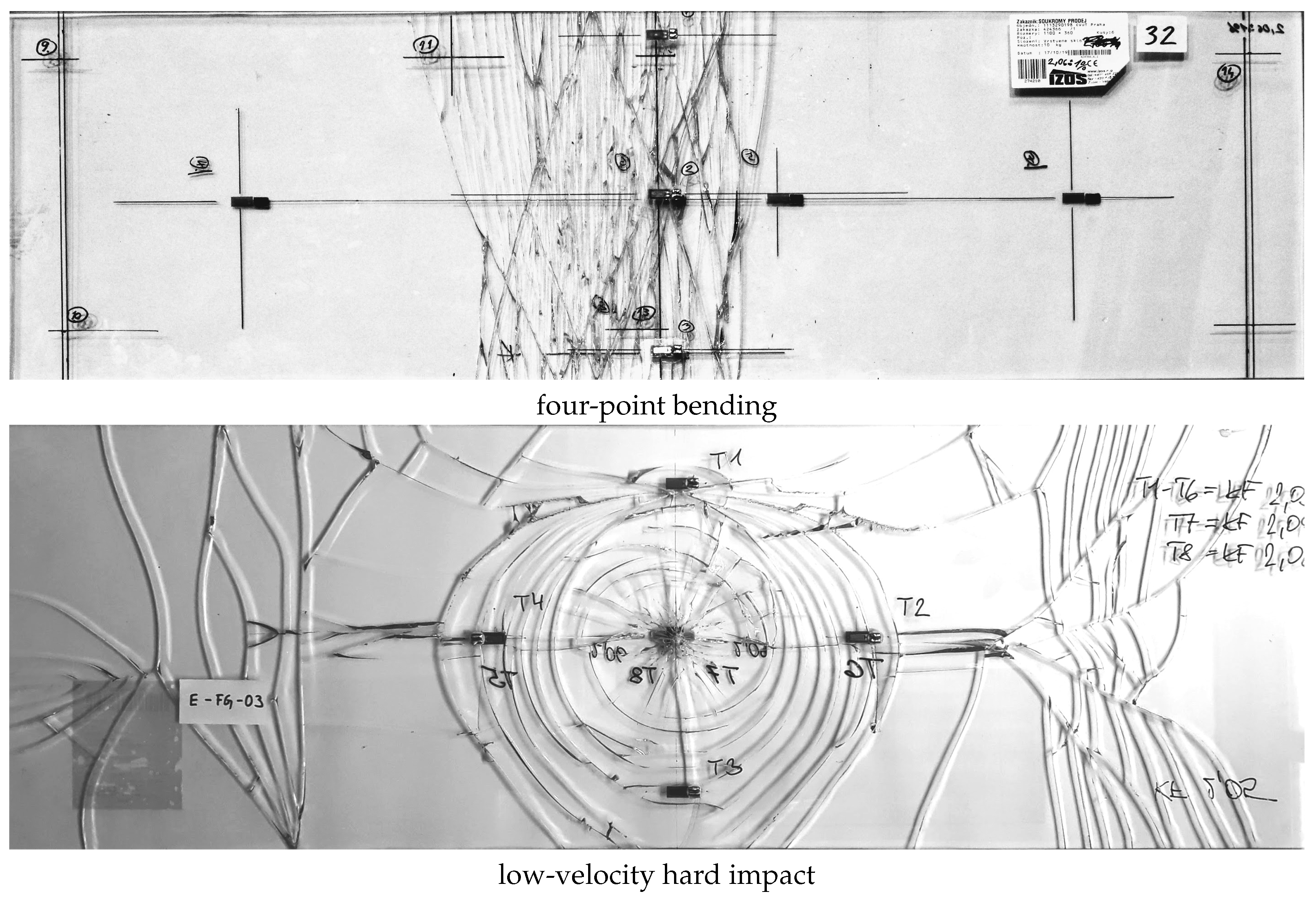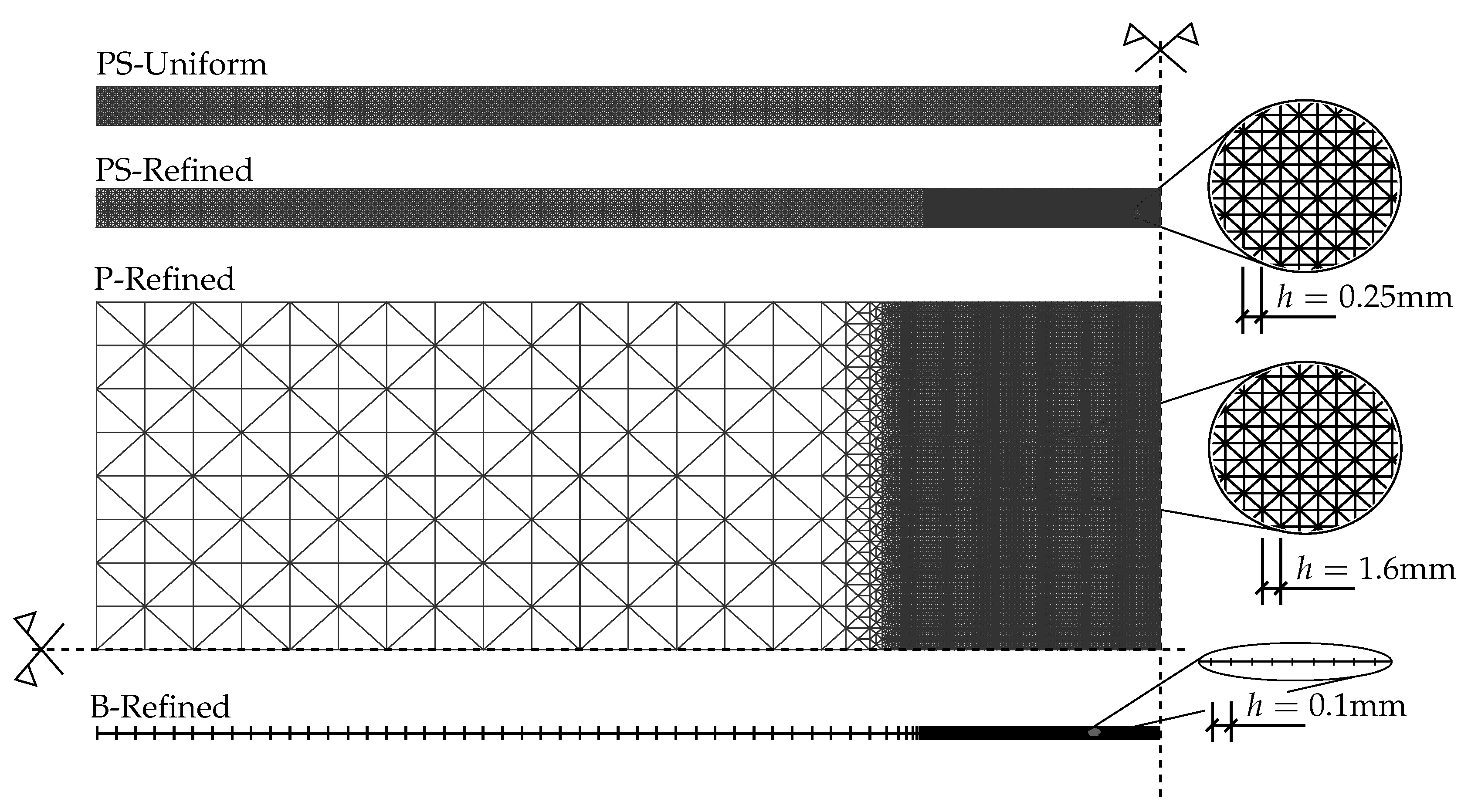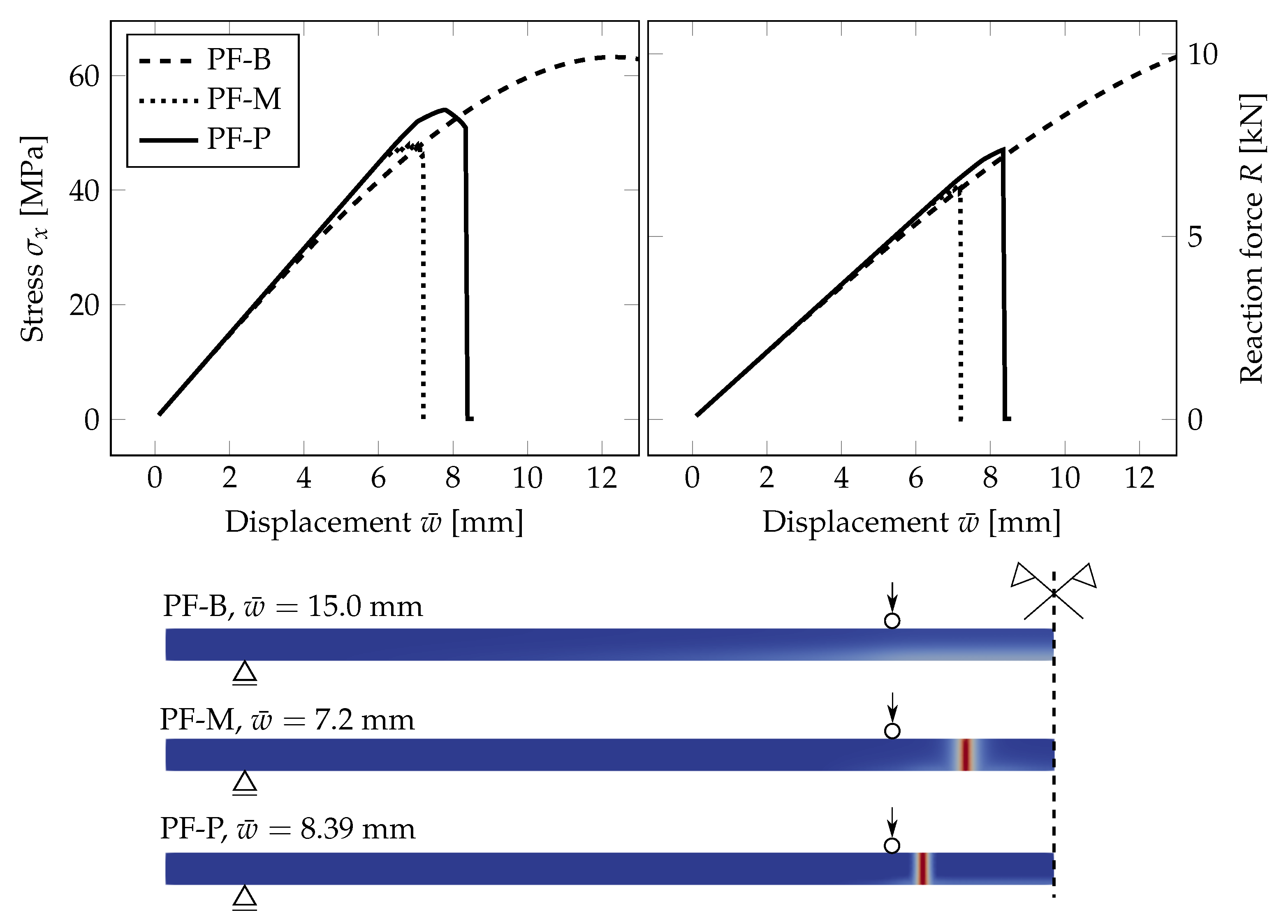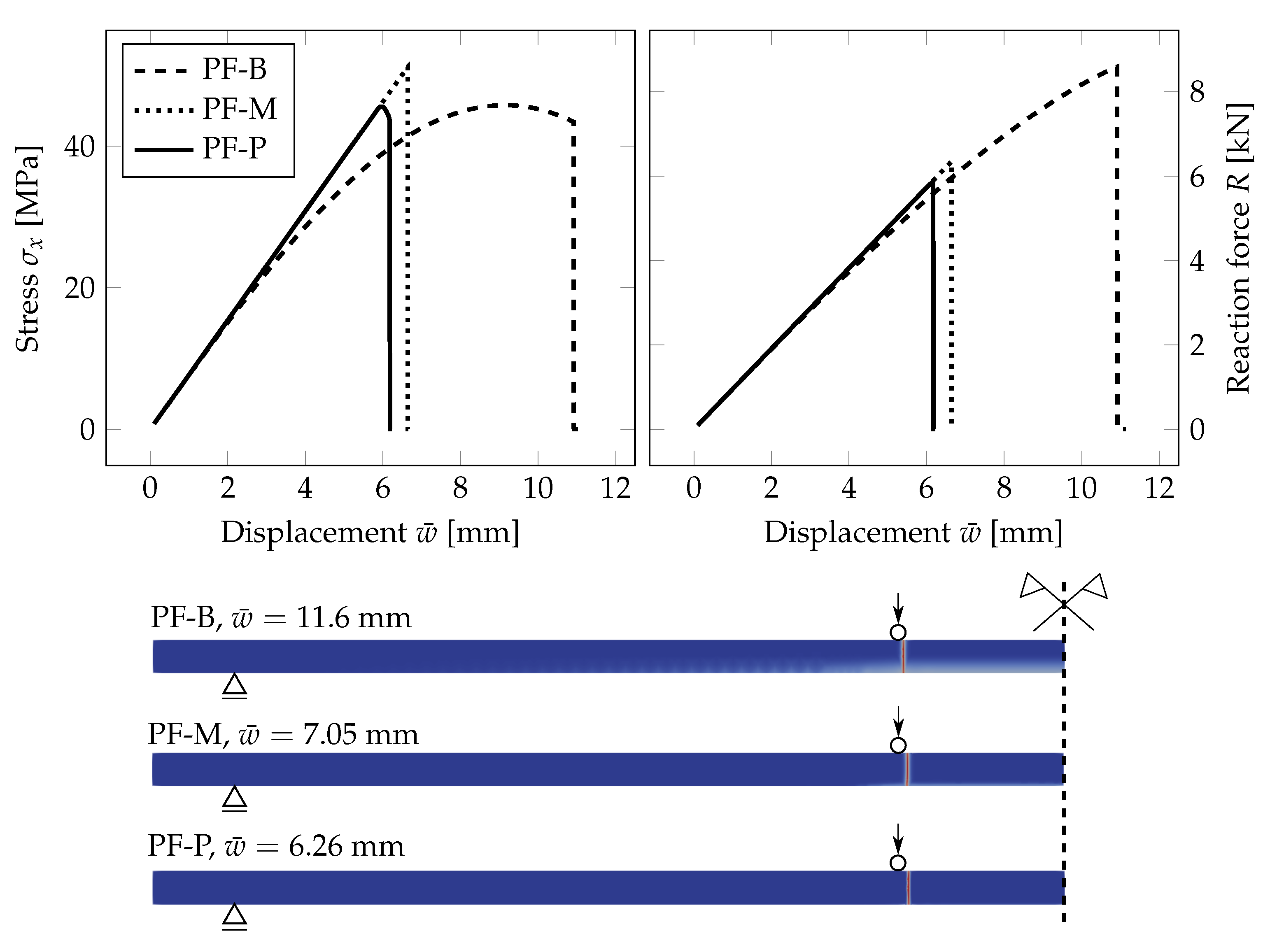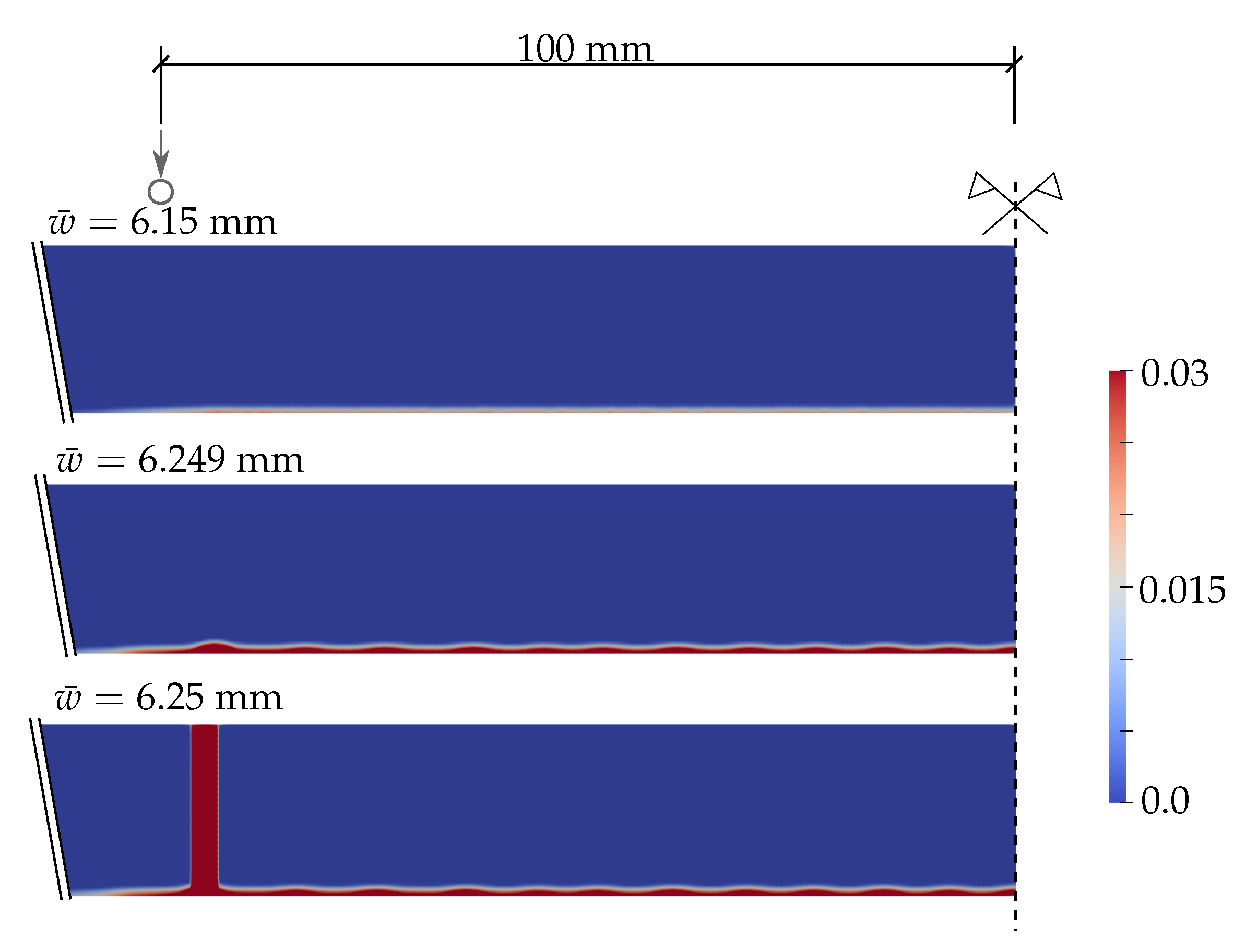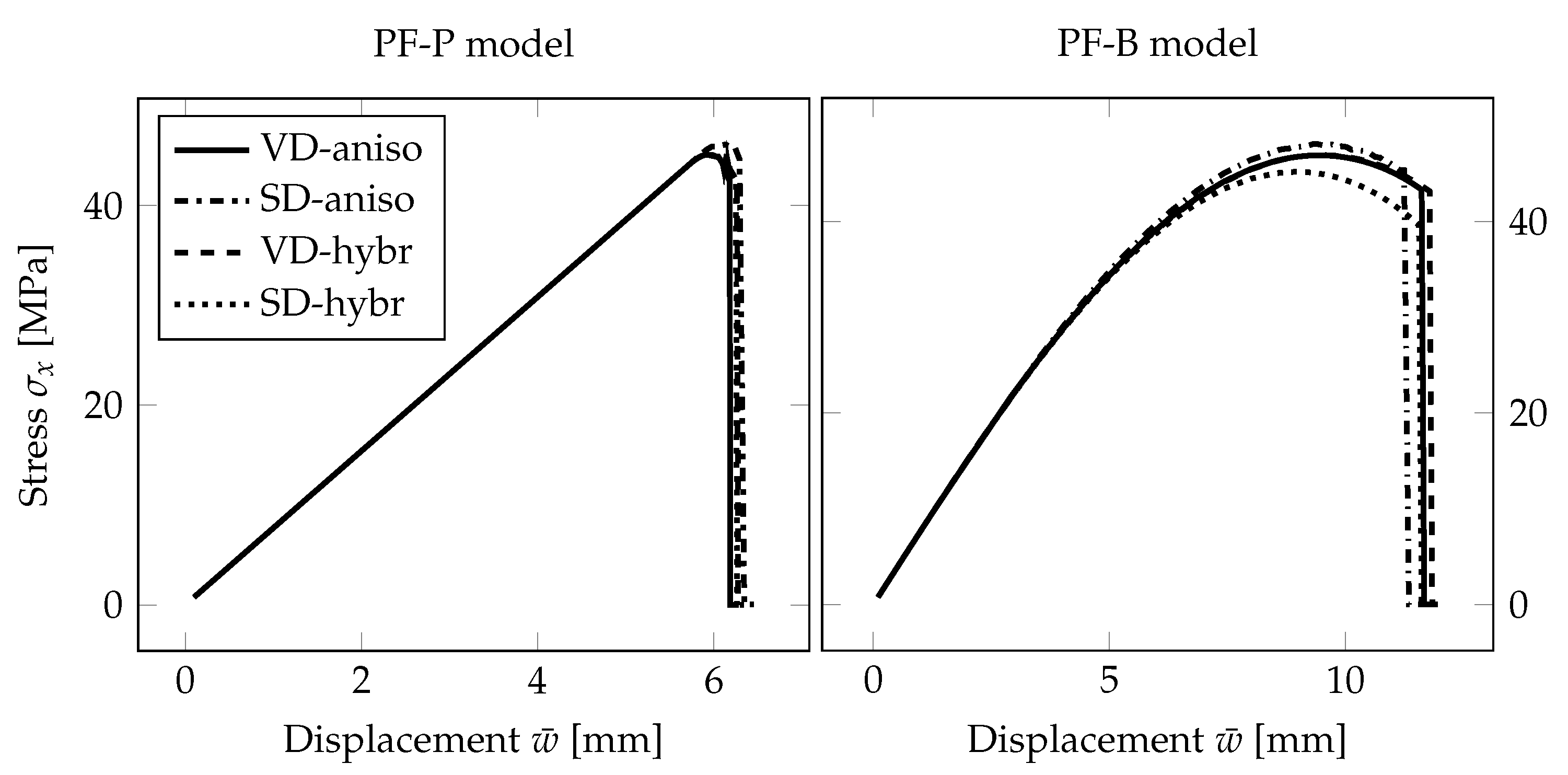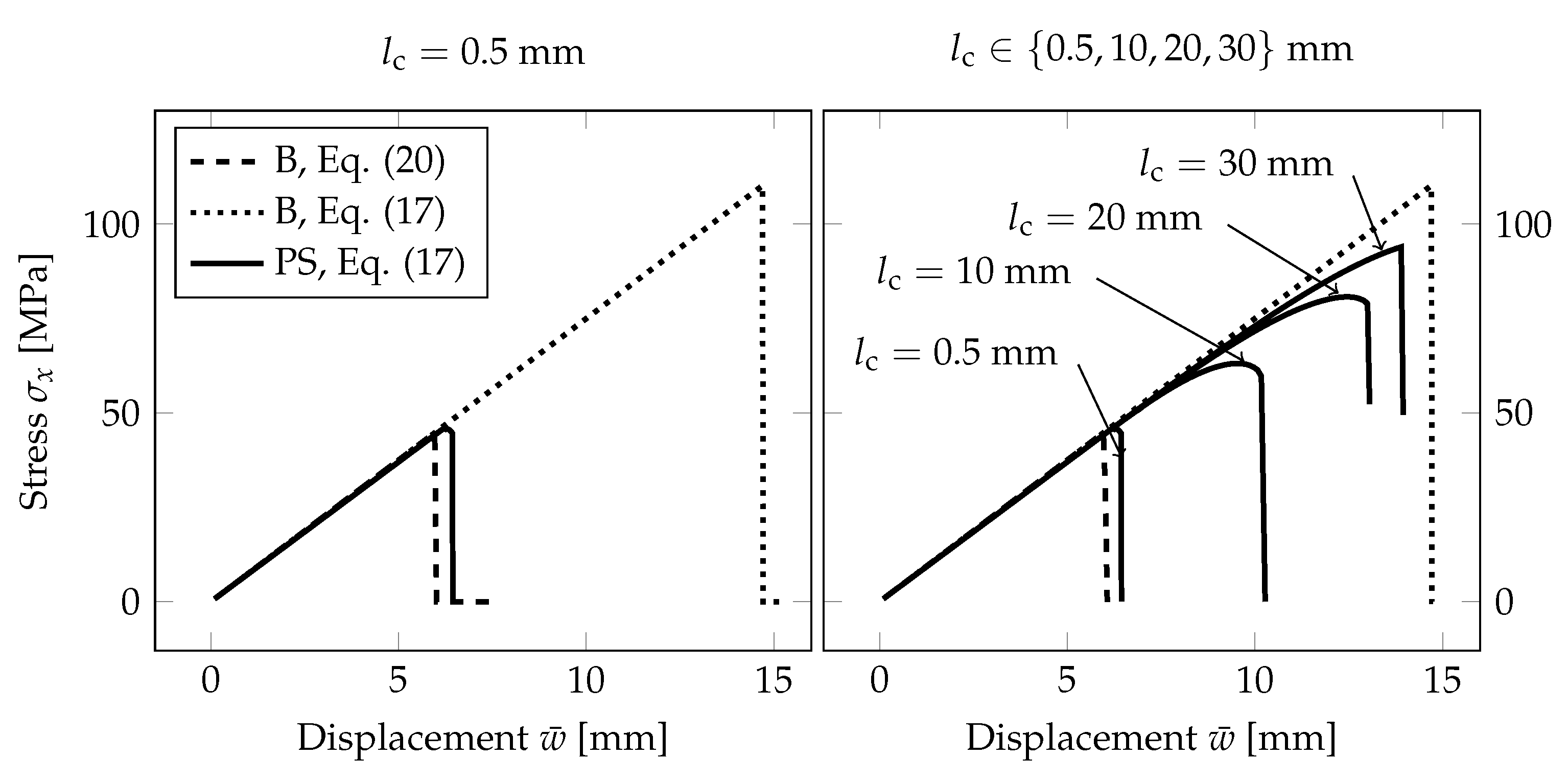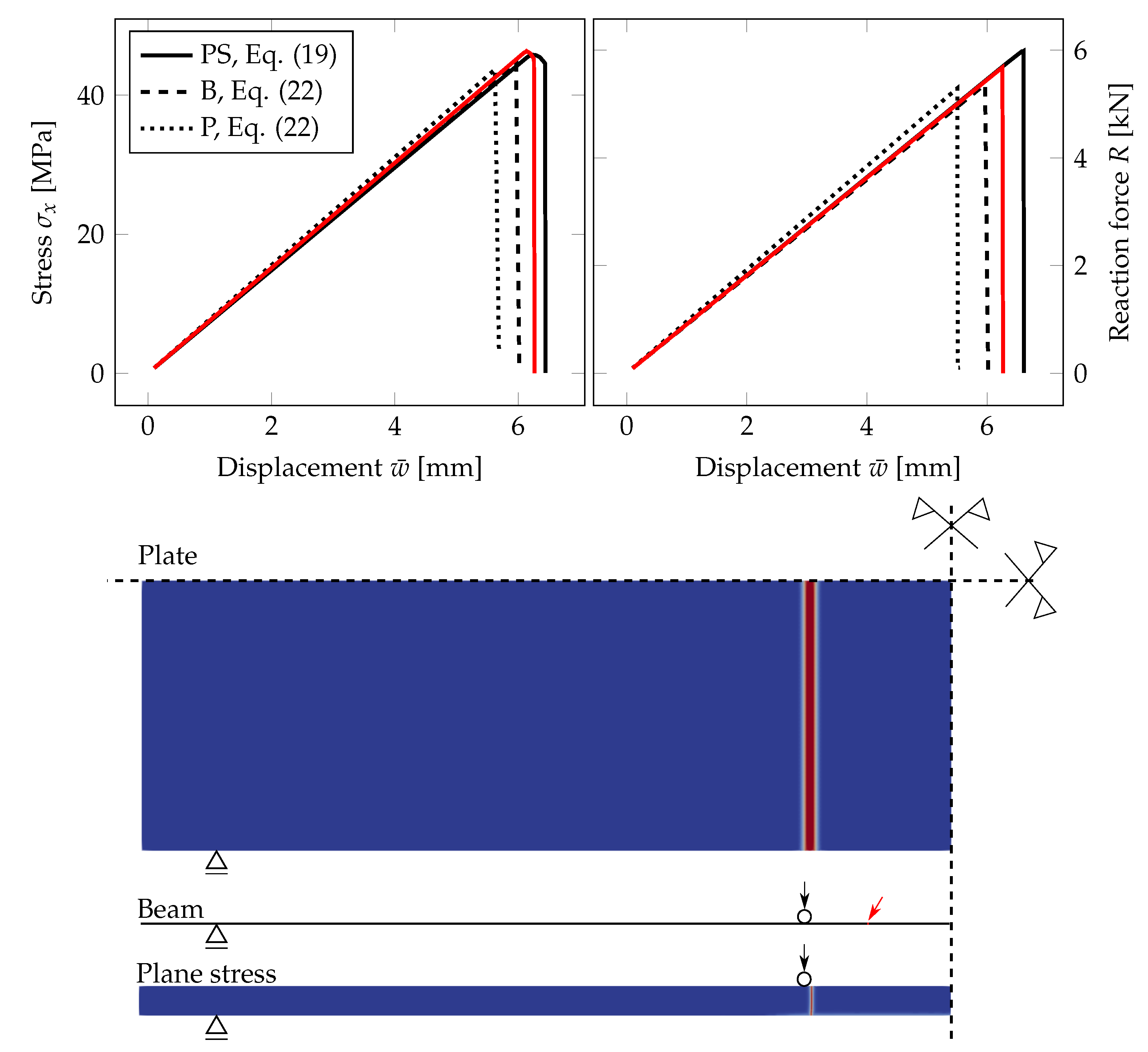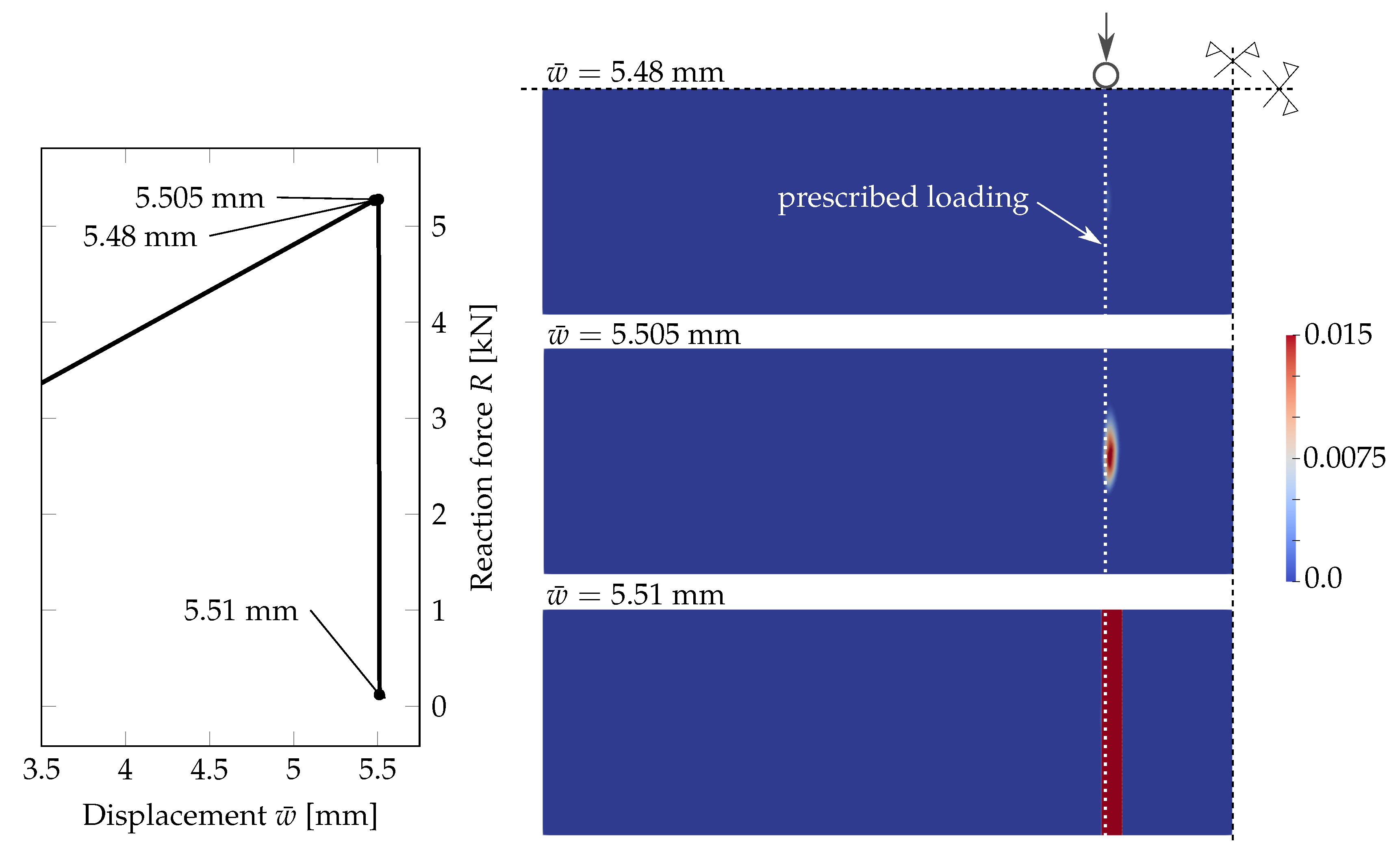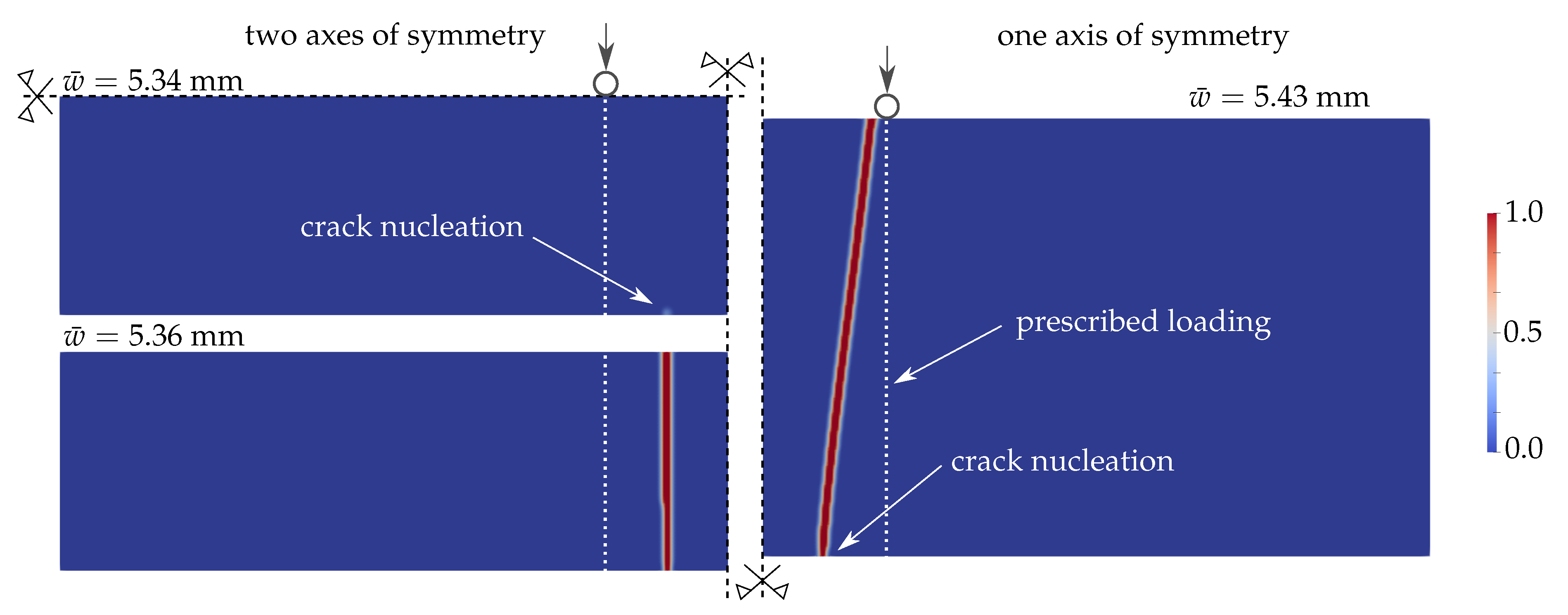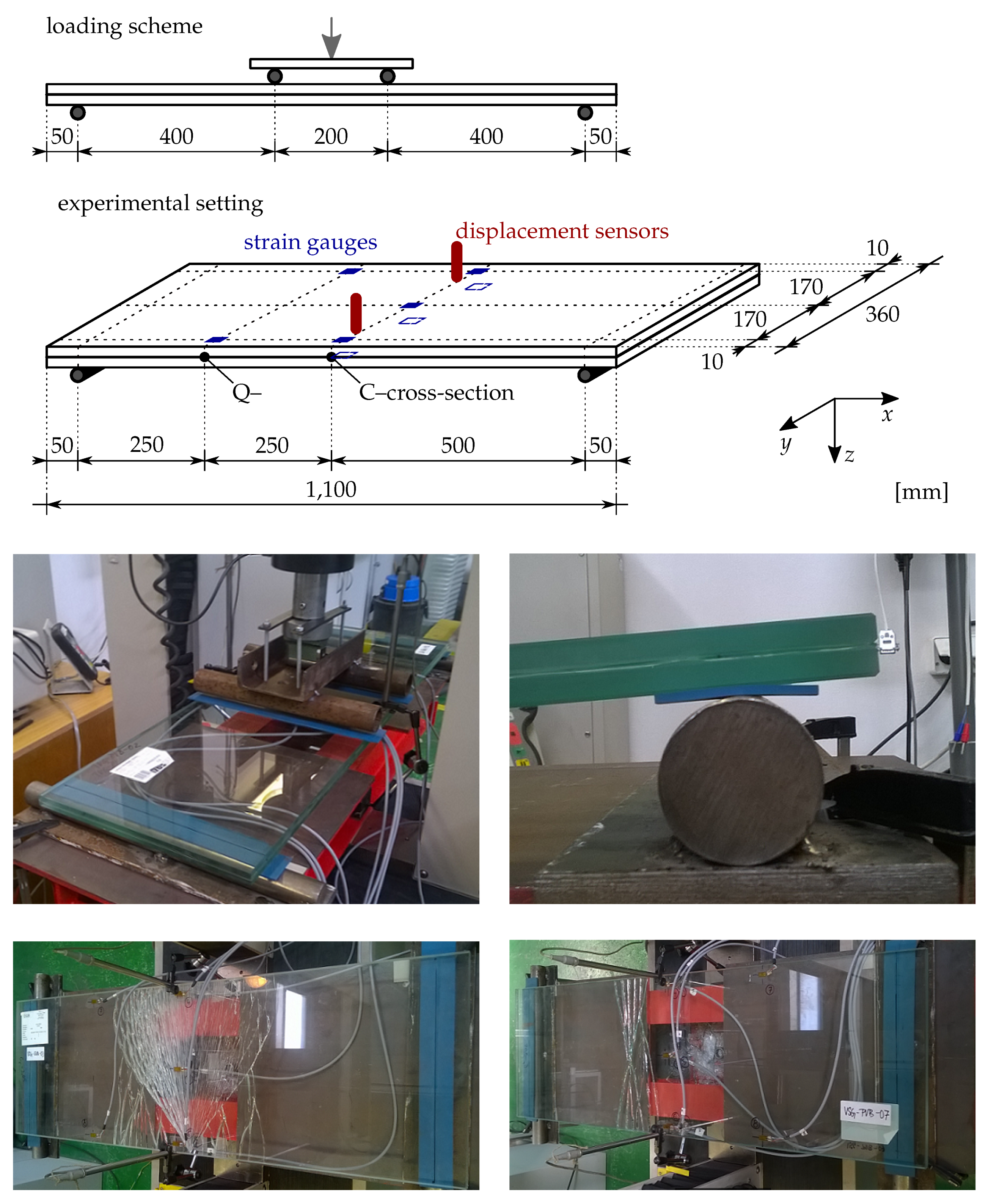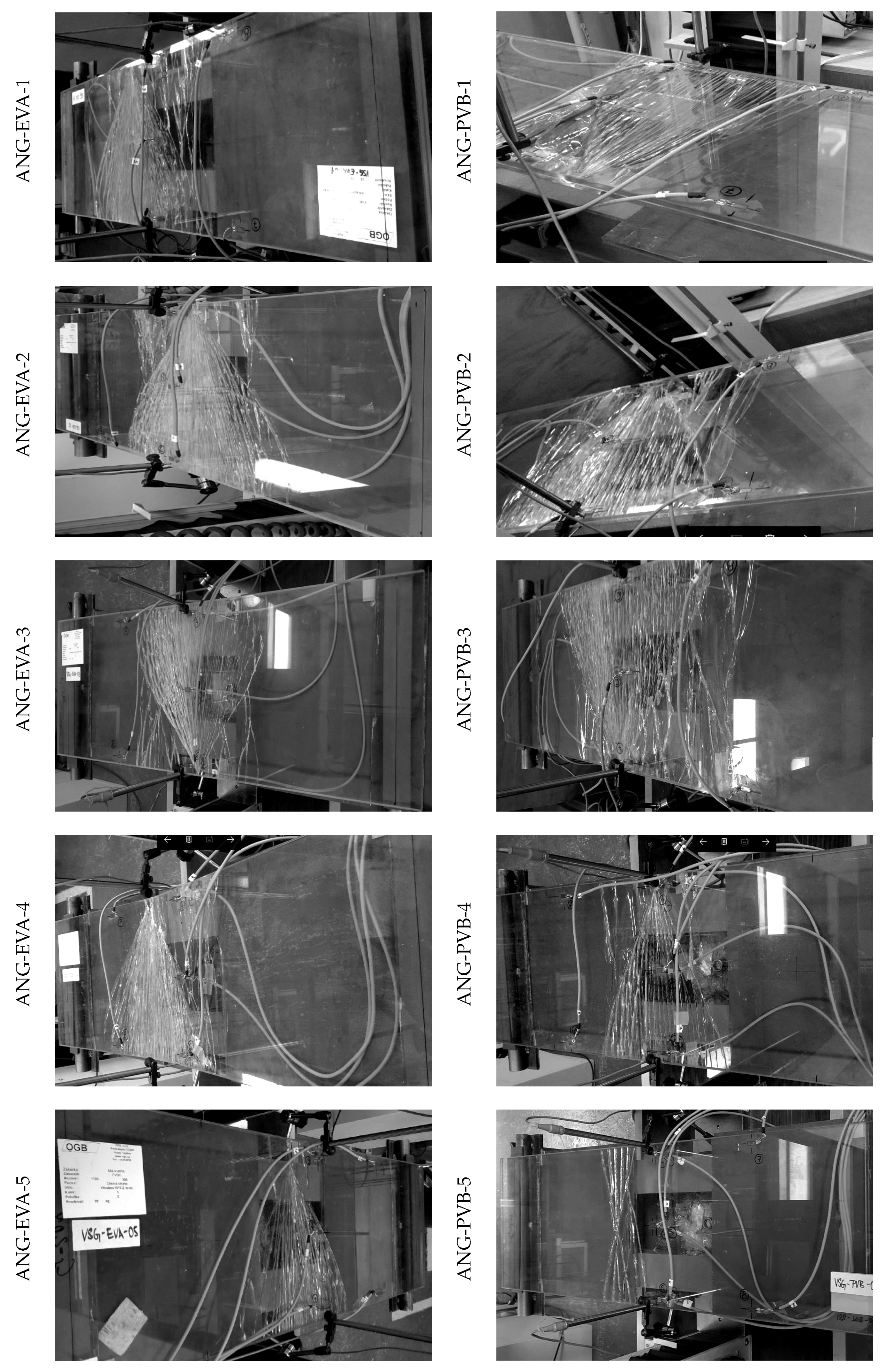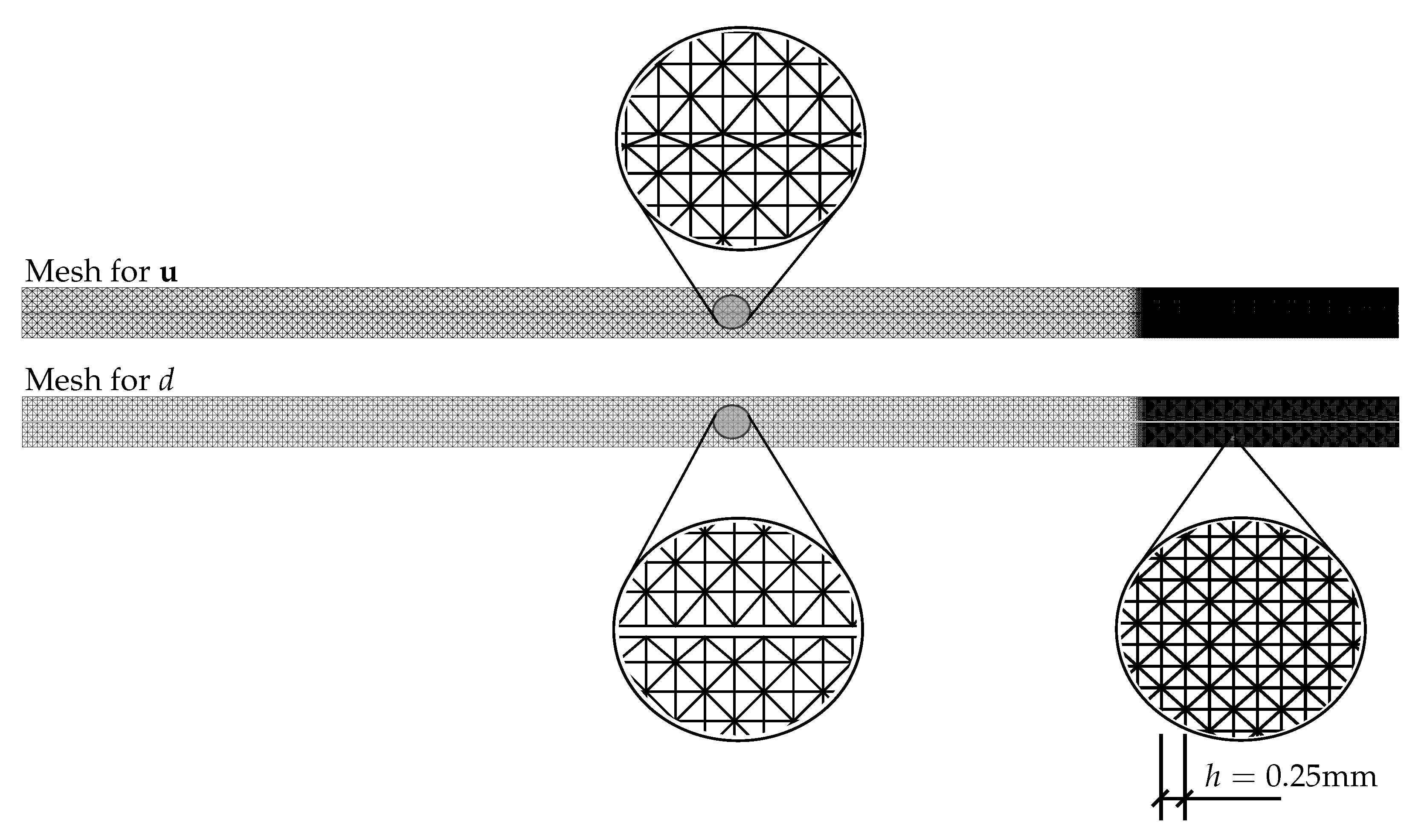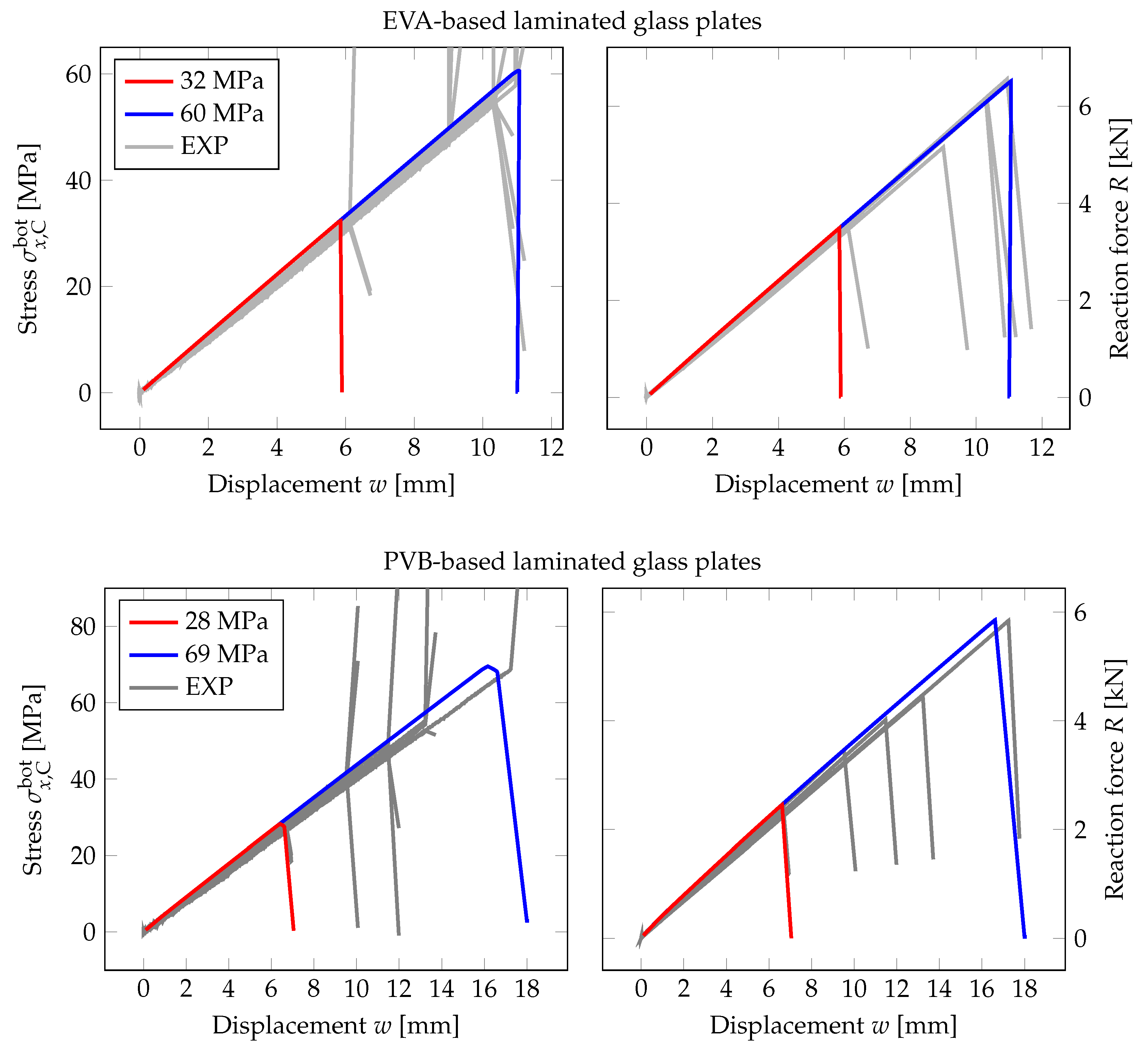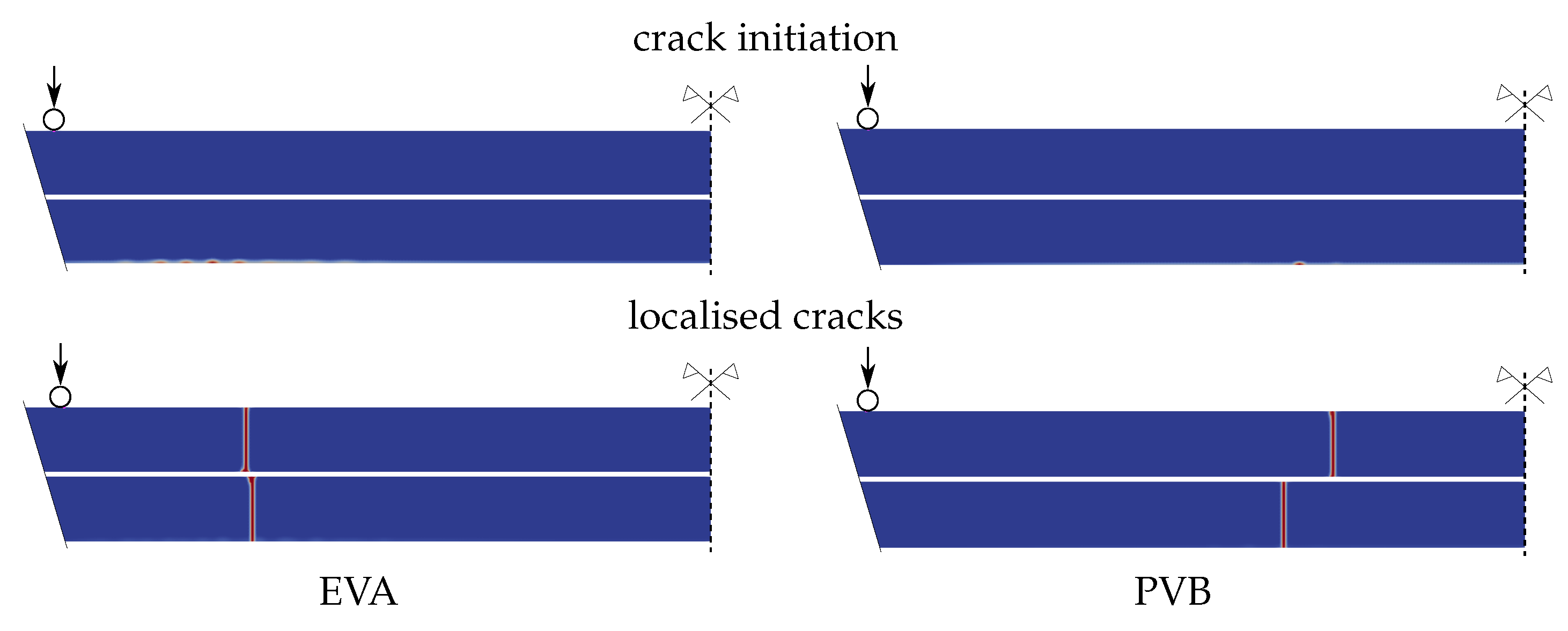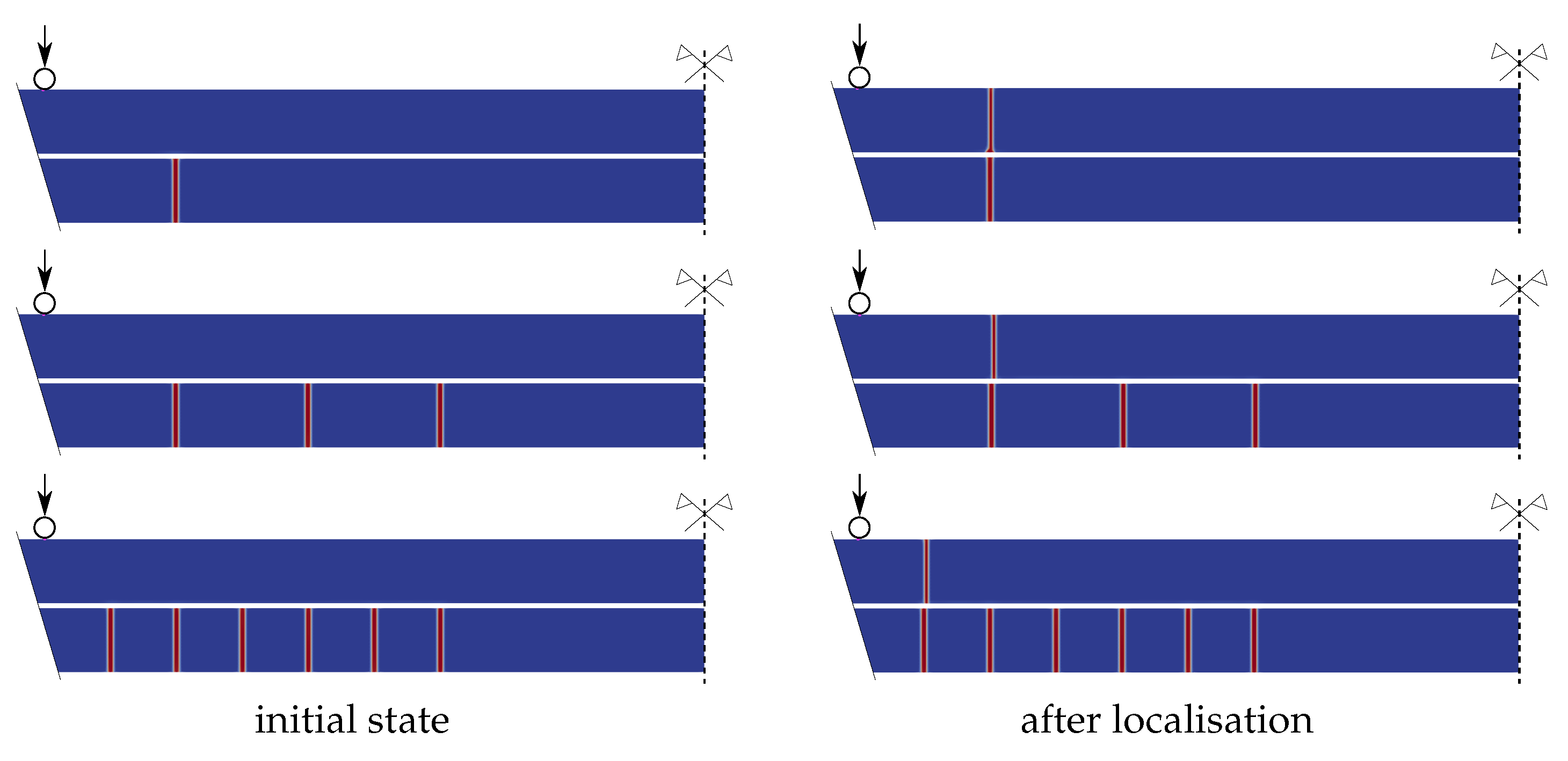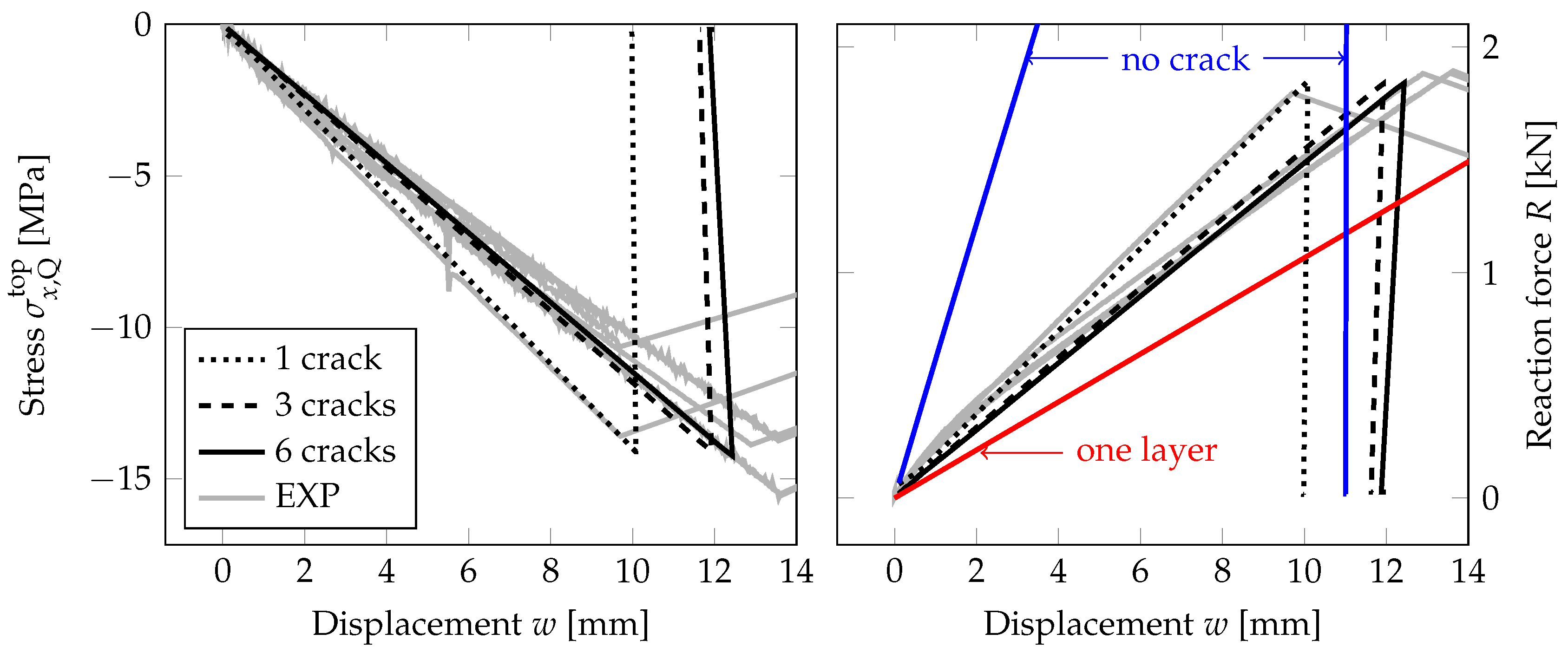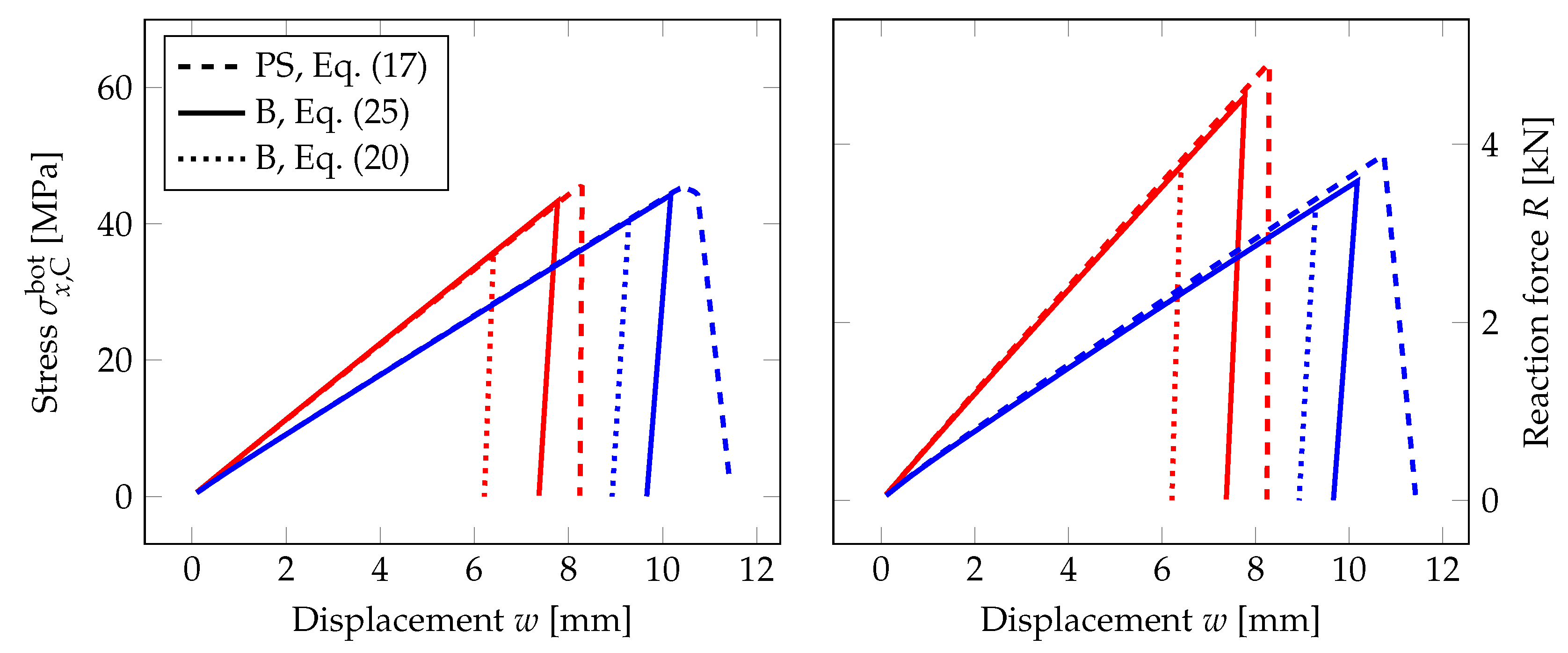Author Contributions
Conceptualization, A.Z. and J.S.; methodology, A.Z., J.S., and J.Z.; software, J.S.; validation, J.S.; formal analysis, A.Z. and M.Š.; investigation, J.S., A.Z., and J.Z.; writing, original draft preparation, A.Z. and J.S.; writing, review and editing, M.Š. and J.Z.; visualization, J.S. and A.Z.; supervision, M.Š. and J.Z.; project administration, M.Š. All authors read and agreed to the published version of the manuscript.
Figure 1.
Photos of fracture patterns for laminated glass samples made of float glass with two edge supports after four-point bending with multiple cracks in the middle part or after the low-velocity hard impact of a steel impactor with a hemispherical head resulting in a spider web crack pattern.
Figure 1.
Photos of fracture patterns for laminated glass samples made of float glass with two edge supports after four-point bending with multiple cracks in the middle part or after the low-velocity hard impact of a steel impactor with a hemispherical head resulting in a spider web crack pattern.
Figure 2.
Schematic diffuse crack approximation of the originally sharp discontinuity and the detail of the damage profiles for two different geometric crack functions corresponding to a one-dimensional localised solution of an infinite bar under tension, i.e., for the PF-B model or for and otherwise for the PF-P model.
Figure 2.
Schematic diffuse crack approximation of the originally sharp discontinuity and the detail of the damage profiles for two different geometric crack functions corresponding to a one-dimensional localised solution of an infinite bar under tension, i.e., for the PF-B model or for and otherwise for the PF-P model.
Figure 3.
Four-point bending loading scheme and geometry of a glass sample and three different spatially reduced models, i.e., 2D plane-stress (PS) longitudinal cross-section, Reissner–Mindlin plate (P), and Timoshenko beam (B).
Figure 3.
Four-point bending loading scheme and geometry of a glass sample and three different spatially reduced models, i.e., 2D plane-stress (PS) longitudinal cross-section, Reissner–Mindlin plate (P), and Timoshenko beam (B).
Figure 4.
Regular uniform or refined discretization for the 2D plane-stress model (PS) and refined meshes used for a quarter of a plate (P) and a half of a beam (B).
Figure 4.
Regular uniform or refined discretization for the 2D plane-stress model (PS) and refined meshes used for a quarter of a plate (P) and a half of a beam (B).
Figure 5.
PS-Uniform mesh, anisotropic staggered solver with the spectral-decomposition split: Comparison of phase-field formulations in terms of the evolution of the largest tensile stress at the midpoint and the overall reaction under the loading points for the prescribed displacement, complemented with the damage evolution plot showing the position of the localised cracks (red).
Figure 5.
PS-Uniform mesh, anisotropic staggered solver with the spectral-decomposition split: Comparison of phase-field formulations in terms of the evolution of the largest tensile stress at the midpoint and the overall reaction under the loading points for the prescribed displacement, complemented with the damage evolution plot showing the position of the localised cracks (red).
Figure 6.
PS-Refined mesh, anisotropic staggered solver with the spectral-decomposition split: Comparison of phase-field formulations in terms of the evolution of the largest tensile stress at the midpoint and the overall reaction under the loading points for the prescribed displacement, complemented with the damage evolution plot showing the position of the localised cracks (red).
Figure 6.
PS-Refined mesh, anisotropic staggered solver with the spectral-decomposition split: Comparison of phase-field formulations in terms of the evolution of the largest tensile stress at the midpoint and the overall reaction under the loading points for the prescribed displacement, complemented with the damage evolution plot showing the position of the localised cracks (red).
Figure 7.
PS-Refined mesh, anisotropic staggered solver with the spectral-decomposition split: Evolution of the phase-field parameter using the PF-P formulation.
Figure 7.
PS-Refined mesh, anisotropic staggered solver with the spectral-decomposition split: Evolution of the phase-field parameter using the PF-P formulation.
Figure 8.
PS-Refined mesh: Comparison of the anisotropic solver, Algorithm 1, employing the volumetric-deviatoric split (VD-aniso) or spectral decomposition approach (SD-aniso) with their counterparts using a linear hybrid formulation (VD-hybr and SD-hybr), Algorithm 2.
Figure 8.
PS-Refined mesh: Comparison of the anisotropic solver, Algorithm 1, employing the volumetric-deviatoric split (VD-aniso) or spectral decomposition approach (SD-aniso) with their counterparts using a linear hybrid formulation (VD-hybr and SD-hybr), Algorithm 2.
Figure 9.
PF-P model, anisotropic staggered approach with the spectral-decomposition split: Comparison of the plane-stress model (PS) with the formulation derived for beams (B) using two constitutive relationships for
,
, and
, i.e.,
from Equation (
17) and
from Equation (
20.)
Figure 9.
PF-P model, anisotropic staggered approach with the spectral-decomposition split: Comparison of the plane-stress model (PS) with the formulation derived for beams (B) using two constitutive relationships for
,
, and
, i.e.,
from Equation (
17) and
from Equation (
20.)
Figure 10.
PF-P formulation, anisotropic staggered approach with the spectral-decomposition split: Comparison of plane stress (PS) for the PS-Refined mesh from
Figure 4 (black line) or additionally refined in the area of the expected crack propagation (red line), beam (B), and plate (P) model in terms of the evolution of the largest tensile stress at the midpoint, the overall reaction, and the damage evolution showing the position of the localised cracks.
Figure 10.
PF-P formulation, anisotropic staggered approach with the spectral-decomposition split: Comparison of plane stress (PS) for the PS-Refined mesh from
Figure 4 (black line) or additionally refined in the area of the expected crack propagation (red line), beam (B), and plate (P) model in terms of the evolution of the largest tensile stress at the midpoint, the overall reaction, and the damage evolution showing the position of the localised cracks.
Figure 11.
PF-P formulation, anisotropic staggered approach with the spectral-decomposition split: Evolution of the phase-field parameter on a quarter of the glass plate.
Figure 11.
PF-P formulation, anisotropic staggered approach with the spectral-decomposition split: Evolution of the phase-field parameter on a quarter of the glass plate.
Figure 12.
PF-P formulation, P mesh, anisotropic staggered approach with the spectral-decomposition split: Evolution of the phase-field parameter on a quarter of the glass plate and the final crack pattern on a half of the plate.
Figure 12.
PF-P formulation, P mesh, anisotropic staggered approach with the spectral-decomposition split: Evolution of the phase-field parameter on a quarter of the glass plate and the final crack pattern on a half of the plate.
Figure 13.
Experimental setup and crack patterns; courtesy of Tomáš Hána from CTU in Prague.
Figure 13.
Experimental setup and crack patterns; courtesy of Tomáš Hána from CTU in Prague.
Figure 14.
Fracture pattern after first loading for laminated glass samples. Both glass layers were damaged for ANG-EVA-4, whereas the fracture patterns for the other samples correspond only to the fracture of the bottom glass layer; courtesy of Tomáš Hána from CTU in Prague.
Figure 14.
Fracture pattern after first loading for laminated glass samples. Both glass layers were damaged for ANG-EVA-4, whereas the fracture patterns for the other samples correspond only to the fracture of the bottom glass layer; courtesy of Tomáš Hána from CTU in Prague.
Figure 15.
Locally refined discretization for the 2D laminated glass plane-stress model. Phase-field variable d is calculated on the sub-mesh in both glass layers only.
Figure 15.
Locally refined discretization for the 2D laminated glass plane-stress model. Phase-field variable d is calculated on the sub-mesh in both glass layers only.
Figure 16.
PF-P formulation, anisotropic staggered approach with the spectral-decomposition split, PS model: Evolution of the largest tensile stress at the midpoint and the overall reaction force under the loading points with respect to the midpoint deflection. Experimental data (EXP, grey lines); numerical response for the lowest measured failure stress (red) and for the highest value (blue).
Figure 16.
PF-P formulation, anisotropic staggered approach with the spectral-decomposition split, PS model: Evolution of the largest tensile stress at the midpoint and the overall reaction force under the loading points with respect to the midpoint deflection. Experimental data (EXP, grey lines); numerical response for the lowest measured failure stress (red) and for the highest value (blue).
Figure 17.
PF-P formulation, anisotropic staggered approach with the spectral-decomposition split, PS model: Crack initiation and localised crack laminated glass samples under four-point bending.
Figure 17.
PF-P formulation, anisotropic staggered approach with the spectral-decomposition split, PS model: Crack initiation and localised crack laminated glass samples under four-point bending.
Figure 18.
Phase-field variable in pre-cracked laminated glass under four-point bending with a different number of initial cracks in a symmetric half of the sample. Initial crack pattern in bottom glass ply and the final fracture for the EVA-based samples for PF-P formulation, anisotropic staggered approach with the spectral-decomposition split, PS model.
Figure 18.
Phase-field variable in pre-cracked laminated glass under four-point bending with a different number of initial cracks in a symmetric half of the sample. Initial crack pattern in bottom glass ply and the final fracture for the EVA-based samples for PF-P formulation, anisotropic staggered approach with the spectral-decomposition split, PS model.
Figure 19.
PF-P formulation, anisotropic staggered approach with the spectral-decomposition split, PS model: Evolution of the compressive stress at a quarter of midspan and the overall reaction under the loading points for the mid-span displacement for the second stage of loading and the EVA-based laminated glass plates. Experimental data (EXP, grey lines) and numerical response for one failure stress of 60 MPa (black) with different number of initial cracks.
Figure 19.
PF-P formulation, anisotropic staggered approach with the spectral-decomposition split, PS model: Evolution of the compressive stress at a quarter of midspan and the overall reaction under the loading points for the mid-span displacement for the second stage of loading and the EVA-based laminated glass plates. Experimental data (EXP, grey lines) and numerical response for one failure stress of 60 MPa (black) with different number of initial cracks.
Figure 20.
PF-P formulation, anisotropic staggered approach with the spectral-decomposition split: Comparison of the response of laminated glass plates with EVA (red line) or PVB (blue line) using the plane-stress (PS) or beam formulation (B). The evolution of the largest tensile stress at the midpoint and the overall reaction under the loading points for the mid-span displacement. The bending strength of glass is set to 45 MPa.
Figure 20.
PF-P formulation, anisotropic staggered approach with the spectral-decomposition split: Comparison of the response of laminated glass plates with EVA (red line) or PVB (blue line) using the plane-stress (PS) or beam formulation (B). The evolution of the largest tensile stress at the midpoint and the overall reaction under the loading points for the mid-span displacement. The bending strength of glass is set to 45 MPa.
Table 1.
Strain energy decompositions: volumetric-deviatoric split (VD) and spectral decomposition (SD), where K stands for the bulk modulus and for Lame’s coefficients. is the deviatoric part of the strain tensor. The Macaulay brackets are defined as , and the positive/negative components follow from the principal strains and the dyadic products of the eigenvectors of .
Table 1.
Strain energy decompositions: volumetric-deviatoric split (VD) and spectral decomposition (SD), where K stands for the bulk modulus and for Lame’s coefficients. is the deviatoric part of the strain tensor. The Macaulay brackets are defined as , and the positive/negative components follow from the principal strains and the dyadic products of the eigenvectors of .
| Split | | |
|---|
| VD | | |
| SD | | |
Table 2.
Phase-field formulations and corresponding functions and parameters. For the PF-M model, the Macaulay brackets are defined as . is a critical fracture stress corresponding to the tensile strength, and are the principal components of the effective stress tensor.
Table 2.
Phase-field formulations and corresponding functions and parameters. For the PF-M model, the Macaulay brackets are defined as . is a critical fracture stress corresponding to the tensile strength, and are the principal components of the effective stress tensor.
| Model | | | | Criterion | |
|---|
| PF-B | | 2 | | energetic | |
| PF-M | | 2 | | Rankine-based (stress) | |
| PF-P | d | | | energetic | |
Table 3.
Elastic material parameters and tensile strength of glass [
51].
Table 3.
Elastic material parameters and tensile strength of glass [
51].
| Glass | |
|---|
| Young’s modulus of elasticity | E | 70 | GPa |
| Poisson’s ratio | | 0.22 | – |
| Tensile strength | | 45 | MPa |
Table 4.
Link between the fracture energy
and the length-scale parameter
seen as a material or numerical parameter using the Young modulus
GPa and the tensile strength for annealed glass
MPa from [
51].
Table 4.
Link between the fracture energy
and the length-scale parameter
seen as a material or numerical parameter using the Young modulus
GPa and the tensile strength for annealed glass
MPa from [
51].
| | [53] | | | | |
|---|
| | (J·m) | (mm) | (mm) | (J·m) | (J·m) |
|---|
| material parameter | 4 | 0.010 | 0.036 |
| numerical parameter | | 3 | 3 | 823 | 231 |
Table 5.
Material composition of the layers in the tested specimens.
Table 5.
Material composition of the layers in the tested specimens.
| Name | Glass | Interlayer | Samples |
|---|
| ANG-EVA | annealed | ethylene-vinyl acetate | 5 |
| ANG-PVB | annealed | polyvinyl butyral | 5 |
Table 6.
Prony series for the generalised Maxwell model with the relaxation times
and corresponding shear moduli
for the reference temperature
and the long-term moduli
kPa for EVALAM 80-120 (EVA) and
kPa for TROSIFOL BG R20 (PVB), [
28].
Table 6.
Prony series for the generalised Maxwell model with the relaxation times
and corresponding shear moduli
for the reference temperature
and the long-term moduli
kPa for EVALAM 80-120 (EVA) and
kPa for TROSIFOL BG R20 (PVB), [
28].
| | EVA | PVB | | EVA | PVB |
|---|
| (s) | (kPa) | (kPa) | (s) | (kPa) | (kPa) |
|---|
| 6933.9 | – | | 445.1 | 587.2 |
| 3898.6 | – | | 300.1 | 258.0 |
| 2289.2 | – | | 401.6 | 63.8 |
| 1672.7 | – | | 348.1 | 168.4 |
| 761.6 | 1,782,124.2 | | 111.6 | – |
| 2401.0 | 519,208.7 | | 127.2 | – |
| 65.2 | 546,176.8 | | 137.8 | – |
| 248.0 | 216,893.2 | | 50.5 | – |
| 575.6 | 13,618.3 | | 322.9 | – |
| 56.3 | 4988.3 | | 100.0 | – |
| 188.6 | 1663.8 | | 199.9 | – |
Table 7.
Parameters for the time-temperature superposition using the William–Landel–Ferry equation [
65].
Table 7.
Parameters for the time-temperature superposition using the William–Landel–Ferry equation [
65].
| | | EVA | PVB | |
|---|
| Reference temperature | | 20 | 20 | |
| Parameters | | 339.102 | 8.635 | – |
| | | 1185.816 | 42.422 | |
| Shift parameter | ) | 0.03769 | 0.1229 | – |
Table 8.
Extreme tensile failure stresses on the bottom surface of laminated glass under four-point bending.
Table 8.
Extreme tensile failure stresses on the bottom surface of laminated glass under four-point bending.
| Samples | Min Failure Stress (MPa) | Max Failure Stress (MPa) |
|---|
| ANG-EVA | 32 | 60 |
| ANG-PVB | 28 | 69 |
